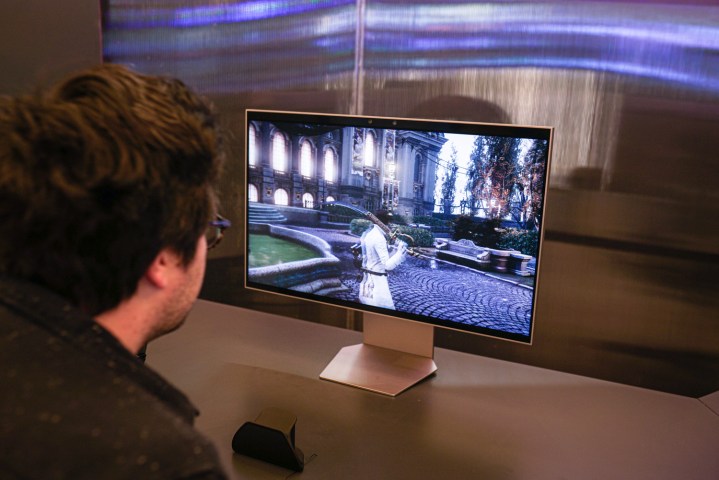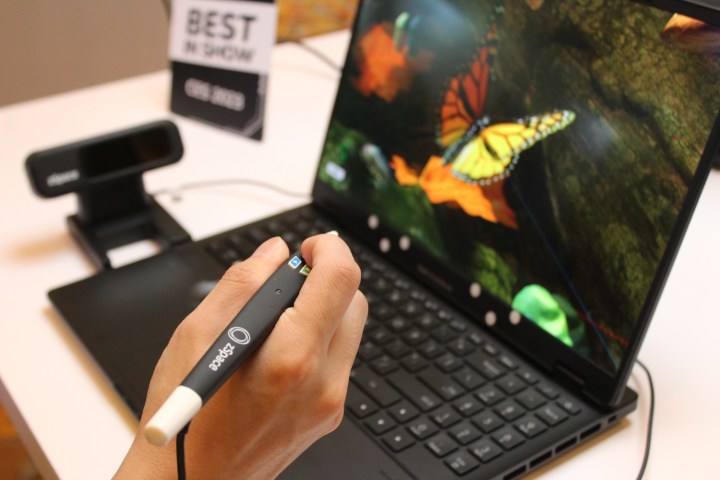
Glasses-free 3D is making a comeback. And please — don’t roll your eyes and write this off as a gimmick just yet.
I saw two similar 3D gaming monitors at CES last week that used this technology and tracked your eyes to fool you into seeing depth in a 2D screen. It’s pretty convincing stuff, especially for games. I really want to see this technology come to fruition, but based on what I’ve seen so far, it needs to be done the right way if it hopes to get people’s attention. The term “3D” has left a bad taste in people’s mouths, and if this new wave of monitors wants to undo that, it needs to make a good first impression.
A tale of two methods
The two 3D gaming monitors I saw at CES shared a lot in common. Both were 27-inch
The first 3D monitor I saw at CES this year was from Samsung, and it was billed more as a tech demo than an actual product. The monitor had the game Lies of P booted up and ready to play, along with a demo that showed navigational UI and demonstrated toggling between 2D and 3D. Both demos impressed me, but obviously, the game was where the magic was. Lies of P looked great, and the 3D effect didn’t take away from the practicality of playing a challenging game like Lies of P. It was easy to get lost in the game, bolstered by the illusion of depth felt through the camera.
According to Samsung, there’s no limit to what games could be played on the monitor, even VR games. At the time, I was thoroughly impressed by how large the “sweet spot” was too. I noticed pretty severe screen tearing happening in background elements, but I chalked it up to early technology.

My opinion changed, however, when I tried the Acer Predator SpatialLabs View 27 the next day. The difference was worlds apart. I played through a beautiful scene in A Plague Tale: Innocence, and it blew me away. Not only was the screen tearing gone, but the sweet spot felt far bigger than on the Samsung monitor. I could even adjust the 3D settings to make the pop-out effect even stronger. The 27-inch monitor also features two forward-facing speakers that include spatial audio, as well.
Just to double-check, I pulled up Lies of P to make for an apples-to-apples comparison. And yep — the difference was still there. And here’s the secret sauce: Acer has a program called the SpatialLabs TrueGame, which configures games with a 3D profile. SpatialLabs has been around for years, and it was the first to market with 3D laptops and monitors, starting with the ConceptD Pro in 2021.
The program launched with 50 titles and is already up to 100, adding around five per month. All this is done without the aid of the developer of the game itself, although Acer hopes that as this technology grows, the process will someday be integrated into game development.
Acer’s approach is much more involved, but it pays off in the end product. Porting over games into 3D straightaway is good, but once you see how they feel on with SpatialLabs TrueGame, it’s hard to go back. One experience left me intrigued — the other made me want this tech now.
Going a step further

We’re only at the beginning of this new world of 3D monitors, and the use case goes beyond gaming, of course. One of the most mind-blowing demos I’ve seen of this technology was a zSpace stylus being used on the Asus ProArt 16 Studiobook 3D, which let you manipulate objects in 3D and bring them right up to your eyes — all without a VR headset or glasses of any kind.
I also saw a demo at CES this year from a company called Breylon that took 3D displays beyond just optical illusions. This is purely in the realm of tech concepts, but the company created a multifocal display that could actually create multiple planes of 3D depth – not the appearance of visual space, but actual layers that your eyes can switch focus between. It’s so real, in fact, that even a camera lens can switch focus between the planes and capture the natural parallax created by them. Gaming is one application, for sure, where a HUD could blend seamlessly into the background as your eyes look past the forward elements. But it could be just as useful for navigation in cars or even basic computing. It’s pretty astounding.
As of now, there’s a limit of power, though. With the stereoscopic 3D in the gaming monitors, you get infinite layers of perceived depth, whereas with Breylon’s approach, you’re limited to two or three on the computers we have today. That’s why a blending of the two approaches might be the best way forward.
How that technology comes together and take shape is pure speculation, but it’ll only happen if manufacturers like Acer and Samsung put their best foot forward when it comes to 3D tech. Knock our socks off. Make us wish we never played a game in 2D ever again. Put these monitors out in the world and give developers the keys to do amazing things with them.
If they can do that, we might be looking at a revolution in gaming that’s far better than strapping a VR headset to your face.
Editors' Recommendations
- 4 CPUs you should buy instead of the Ryzen 7 7800X3D
- Nvidia turns simple text prompts into game-ready 3D models
- This OLED portable monitor can fold right in half
- HP takes on Alienware and Samsung with its 4K QD-OLED gaming monitor
- Samsung has a 3D gaming monitor that doesn’t need glasses — and it actually works



